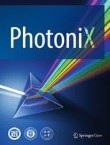Optical encryption plays an increasingly important role in the field of information security owing to its parallel processing capability and low power consumption. Employing the ultrathin metasurfaces in optical encryption has promoted the miniaturization and multifunctionality of encryption systems. Nevertheless, with the few number of degrees of freedom (DoFs) multiplexed by single metasurface, both key space and encoding space are limited. To address this issue, we propose a high-security and large-capacity optical encryption scheme based on perfect high-dimensional Poincaré beams with expanded DoFs. By cascading two arrayed metasurfaces, more beam properties can be independently engineered, which gives rise to the extensively expanded key and encoding spaces. Our work provides a promising strategy for optical encryption with high security level and large information capacity and might facilitate the applications of Poincaré beams in optical communications and quantum information.
Nanoimprint lithography (NIL) has attracted attention recently as a promising fabrication method for dielectric metalenses owing to its low cost and high throughput, however, high aspect ratio (HAR) nanostructures are required to manipulate the full 2π phase of light. Conventional NIL using a hard-polydimethylsiloxane (h-PDMS) mold inevitably incurs shear stress on the nanostructures which is inversely proportional to the surface area parallel to the direction of detachment. Therefore, HAR structures are subjected to larger shear stresses, causing structural failure. Herein, we propose a novel wet etching NIL method with no detachment process to fabricate flawless HAR metalenses. The water-soluble replica mold is fabricated with polyvinyl alcohol (PVA) which is simpler than an h-PDMS mold, and the flexibility of the PVA mold is suitable for direct printing as its high tensile modulus allows high-resolution patterning of HAR metalenses. The diffraction-limited focusing of the printed metalenses demonstrates that it operates as an ideal lens in the visible regime. This method can potentially be used for manufacturing various nanophotonic devices that require HAR nanostructures at low cost and high throughput, facilitating commercialization.
